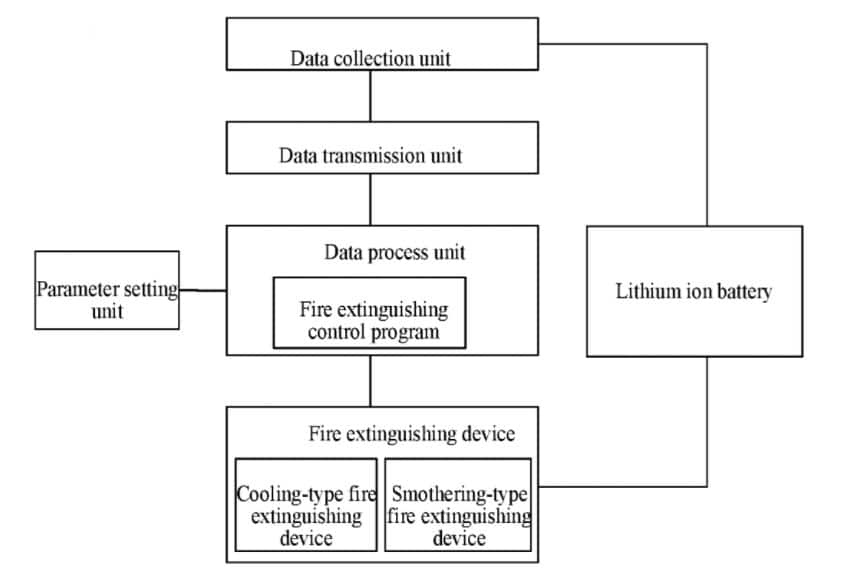A new U.S. patent application outlines how to create batteries capable of cooling themselves down, and in extreme cases, extinguishing their own flames.
The system specifically targets Lithium-ion systems consisting of battery boxes. Li-ion is the industry standard for rechargeable technology, used in a wide variety of applications, from phones to cars to medical equipment. Unfortunately, these common components are subject to a chemical chain reaction called thermal runaway. This describes the event when gases inside the battery cause an otherwise harmless amount of heat to feed itself that can result in combustion or even explosion.
There are no definitive statistics on how many fires Lithium-ion batteries have caused, but such incidents have received widespread media coverage in recent years; notable examples include the self-combusting batteries in certain Samsung phones and exploding lithium-ion products sold by Amazon. Both cases involved Chinese manufacturers, which have been called out by key players in the rechargeable battery industry for their non-compliance with safety standards. There were demands for stricter regulations in China, which Beijing implemented a few years later.
The patent application for self-cooling, self-extinguishing Li-ion batteries appears to be another government effort. It was submitted by the State Grid Corporation of China, the world’s largest utility company, along with its subsidiary, the China Electric Power Research Institute.
According to the document, the technology may be installed into battery boxes or other containers where one or more li-ion batteries are stored. It comprises a data collection unit, a data transmission unit, a data process unit, a parameter setting unit, and a fire extinguishing device.

A structural diagram of a fire extinguishing system for a lithium-ion battery according to an optional embodiment of the present disclosure.
The data collection unit tracks environmental parameters within a battery box in real-time. A battery box may come equipped with sensors for temperature, smoke concentration, and flame intensity.
The data transmission unit communicates the environmental parameters to the data process unit, which determines the safety level of the Li-ion batteries. The safety levels are determined by the parameter setting unit, configured with thresholds for temperature, smoke concentration, and smoke intensity. The thresholds are set accordingly depending on the monitored Li-ion battery’s type and energy level.
The patent application mentions safety levels 1, 2, 3: level 3 being the safest and where the fire extinguishing device stays inactive. Safety level 2 is when the Li-ion batteries reach 65°C and risk thermal runaway. At this level, the system is prompted to deploy a cooling-type fire extinguishing agent to bring the temperature down.
The inventors cite the difficulty of putting out Lithium chemical fires as well as their high risk of reignition. Safety level 1 signifies the presence of an open fire. The system prioritizes depriving the flame of oxygen and does so by closing the space around the battery and spraying a smothering-type fire extinguishing agent.
After the container is filled, the fire extinguishing device switches to spraying the cooling-type agent for 5 to 10 minutes. If the battery reignites, more extinguishing agents are deployed. After another 5 to 10 minutes, a fan is started or the battery cabinet is opened to dissipate heat. The system continuously monitors the battery temperature and employs cooling agents as needed.
The fire extinguishing strategies are deployed via a pre-written control program, installed onto an electronic device inside the battery box. The program handles how much and how often extinguishing agents are deployed.
Portable electronic devices have been relying on rechargeable Li-ion batteries for about three decades, and the rollout of technology with this type of battery shows no signs of slowing down. The system outlined in the patent application may even be implemented in electric vehicles. With EV adoption ramping up, manufacturers may look into ways to improve the safety of EV batteries. Tesla cars, for example, utilize Li-ion cells housed in modules, which themselves are housed in one large shell. These enclosures may serve as analogs for the battery boxes detailed in the patent application.
The featured patent application, “Fire Extinguishing Method And Fire Extinguishing System For Lithium Ion Battery, Electronic Device And Storage Medium”, was filed with the USPTO on July 16, 2019 and published thereafter on July 8, 2021. The listed applicants are the State Grid Corporation of China and the China Electric Power Research Institute Company Limited. The listed inventors are Fei Gao, Mengmeng Geng, Guangqing Jia, Chaoqun Liu, Hao Liu, Kaifeng Wang, Kangkang Wang, Kai Yang, and Mingjie Zhang.



